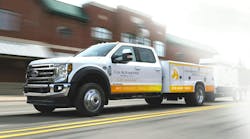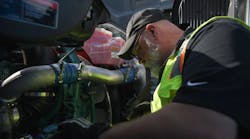A panel of industry experts discussed challenges in the heavy duty collision repair market with proper parts identification, challenges with parts availability and the need for recommended procedures during the HD Repair Forum in Fort Worth, Texas. Held April 2 and 3, the second annual HD Repair Forum provided members of the heavy duty body shop service and collision repair industry with opportunities to further educate and understand key issues.
The panel featured industry representatives providing perspective from truck manufacturers, insurance claims and service estimators, and vehicle body and collision repairers, including:
- Kevin Clary, Product Marketing Manager, Daimler Trucks North America
- Gary Gumushian, Vice President - Global Automotive Center, Solera - Audatex
- Rohit Mathew , Manager, Carlisle & Company
- T.J. O'Hanlon, Director - Private Label Brands, Navistar
- Mark Polzin, President, Budget Truck & Auto
A common theme with the parts discussion referenced the challenges and current status of the automotive collision market, and the advancements in parts identification and standardized repair procedures from OEs for light duty vehicles compared to the heavy duty market.
Parts identification and procurement
A challenge for many independent heavy duty collision repair shops is the proper identification of the part.
Original equipment (OE) vehicle manufacturers are working to provide a method of easier parts lookup and identification through ecommerce platforms, according to both DTNA's Clary and Navistar's O'Hanlon. Both OE representatives confirmed so long as the independent repair facility is a registered customer of the respective OE's ecommerce platform, they should have access to it. Clary advised repairers must work with their local dealership to have access for Daimler vehicles. With that access, they can look up the vehicle, see parts inventory at the local dealer and inventory in the distribution centers to confirm parts availability.
O'Hanlon acknowledged the need to provide cross-reference capabilities for the aftermarket as well. "We need to make sure the customer experience is as seamless as possible," he says.
"There are so many variables that it makes it difficult for us to find the right part," Budget Truck & Auto's Polzin says. Regardless of procurement of that part - whether it's from a dealership, aftermarket distributor or salvaged - the method is similar, he explains. Polzin says his team will take a photo of the part or area of the vehicle, and provide that information in person or by email to the parts provider.
Solera's Gumushian said it's more challenging to identify the proper part for a heavy duty commercial vehicle due to the widespread customization of vehicles, compared to the automotive market. Solera provides estimating software for both the automotive and heavy duty vehicles for independent shops. Gumushian recommends a vehicle identification number (VIN) system, like the light duty market, to help more easily identify proper parts.
"It almost needs to be a VIN-based system for the heavy duty truck to help identify the parts," he says. "We’ve developed both, because we have 88 different truck models, and 19 different OEs, in our system. This takes a lot of manual effort."
Parts returns, including re-crating and restocking fees, have been a continued challenge. The issue was also brought up at least year's HD Repair Forum, and Polzin confirms there seems to have been some improvement. "Restocking fees have not gone away, but we’ve done better at eliminating the wrong parts ordered. It’s not anywhere where it needs to be."
"Bringing this to the automotive side, and the associated cost of doing it right the first time (with parts identification)," Mathew adds. "There’s an associated cost on both sides of the line. The access to information and being able to identify (the part) correctly helps limit that cost. On the automotive side we’ve seen a reduction with that because of easier identification of these products."
Having the proper part is key, but the time it takes to get that part - if it's even available - has also been a challenge.
Proper repair procedures
"Information is huge; we need to share the information," Polzin stresses. "We need to work together (as an industry) so we can share it with our techs. In our society, techs are hard to find but they’re interested in the technology. We can entice these employees to work with our industry."
Overall, panelists agreed customer experience is a key driver to improving the parts procurement process. This is done through communication and standardization.
"Certification programs for OEs really focus on the cycle time number because driving that down helps serve everybody better and improves customer experience. This could be technology solutions, checklists, or whatnot, but getting the information out there helps lower that (cycle time) number," Mathew said.
"We’re 10 years behind the automotive sector in everything we do in this space. We don't have anything like that currently," he adds.
The need for these standardized procedures is critical to ensure the repair is done properly, especially from a safety standpoint. For instance, proper procedures for handling seat belt repair and replacement.
"We're held liable to the customer and the insurance company with explanations on why we’re doing what we’re doing," Polzin says. "We attend classes to understand how to repair it, but no one has stepped up with a specific repair procedures. The insurance (companies) just need an explanation, and they'll pay for it. That’s why it’s important for us to get info from the (vehicle manufacturers)."
"Insurance needs an explanation for what’s happening," Mathew adds. "Especially with the new technology placed on cars and vehicles, it’s becoming far more important in the repair process itself."
Gumushian suggested the possibility of working with other industry groups, such as the American Trucking Associations' Technology & Maintenance Council, to create standardized procedures.
"The thing that’s most important to the customer is uptime," says Gumushian. "More uptime for that truck, provides more value and revenue for the driver and the company."
Clary advised OEs are looking at ways to work and collaborate with the aftermarket, but there are sometimes challenges.
"It’d be great to make that information available," he says. "Internally we have battles where 'How much do we share?' Every truck is a one-off build, so there is a lot of old-school thinking about how to handle that. We need a regime that changes that, until then it’s going to be slow-going from some of the providers."



